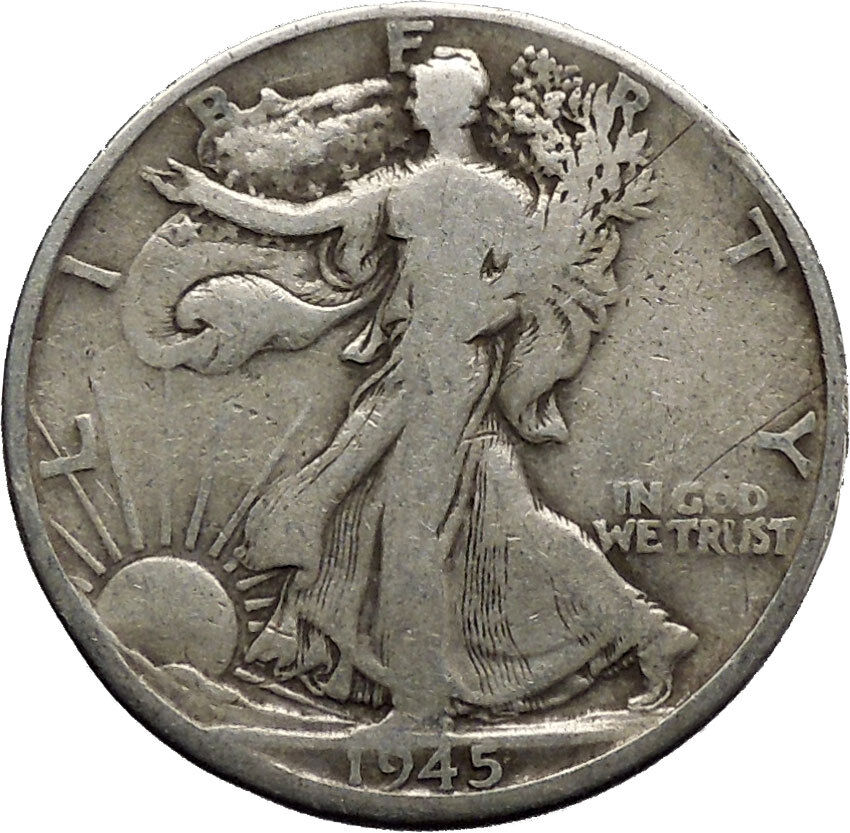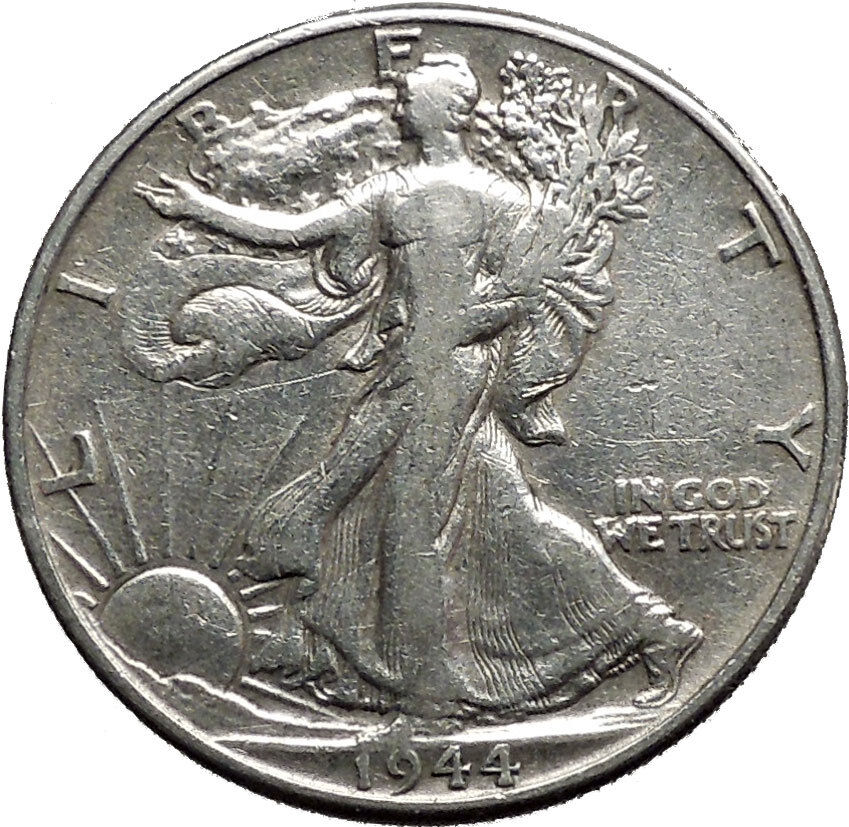|
United States of America – Walking Liberty Half Dollar
1942 P Silver Half Dollar (50 Cents) 29mm (12.38 grams) 0.900 Silver (0.3617 oz. ASW) Philadelphia mint
Reference: KM# 142
LIBERTY IN GOD WE TRUST, Lady Liberty, the folds of the Stars and Stripes flying to the breeze as a background, progressing in full stride toward the dawn of a new day, carrying branches of laurel and oak, symbolical of civil and military glory. The hand of the figure is outstretched in bestowal of the spirit of liberty. Year of mintage below.
UNITED•STATES•OF•AMERICA• HALF•DOLLAR, a bald eagle perched high upon a mountain crag, his wings unfolded, fearless in spirit and conscious of his power. Springing from a rift in the rock is a sapling of mountain pine, symbolical of America; E PLURIBUS UNUM “out of many, one” in field to left. Mint letter (if any) in bottom left field.
The designer of this coin was Adolph A. Weinman, who signed the coin with his monogram AW below the tips of the tail feathers. The coin was struck at three mints, Philadelphia (ones without any mint letter), Denver (D), and San Francisco (S).
You are bidding on the exact item pictured, provided with a Certificate of Authenticity and Lifetime Guarantee of Authenticity.
The Walking Liberty half dollar was a silver 50-cent piece or half dollar coin issued by the United States Mint from 1916 to 1947; it was designed by Adolph A. Weinman.
In 1915, the new Mint Director, Robert W. Woolley, came to believe that he was not only allowed but required by law to replace coin designs that had been in use for 25 years. He therefore began the process of replacing the Barber coinage: dimes, quarters and half dollars, all bearing similar designs by long-time Mint Engraver Charles E. Barber, and first struck in 1892. Woolley had the Commission of Fine Arts conduct a competition, as a result of which Weinman was selected to design the dime and half dollar.
Weinman’s design of Liberty striding towards the Sun for the half dollar proved difficult to perfect, and Treasury Secretary William G. McAdoo, whose department included the Mint, considered having Barber create his own design. Mint officials were successful in getting Weinman’s design into production, although it never struck very well, which may have been a factor in its replacement by the Franklin half dollar beginning in 1948. Nevertheless, art historian Cornelius Vermeule considered the piece to be among the most beautiful US coins. Since 1986, a modification of Weinman’s obverse design has been used for the American Silver Eagle.
 The bald eagle (Haliaeetus leucocephalus, from Greek hali-=sea, aiētos=eagle, leuco-=white, cephalos=head) is a bird of prey found in North America. A sea eagle, it has two known sub-species and forms a species pair with the white-tailed eagle (Haliaeetus albicilla). Its range includes most of Canada and Alaska, all of the contiguous United States, and northern Mexico. It is found near large bodies of open water with an abundant food supply and old-growth trees for nesting. The bald eagle (Haliaeetus leucocephalus, from Greek hali-=sea, aiētos=eagle, leuco-=white, cephalos=head) is a bird of prey found in North America. A sea eagle, it has two known sub-species and forms a species pair with the white-tailed eagle (Haliaeetus albicilla). Its range includes most of Canada and Alaska, all of the contiguous United States, and northern Mexico. It is found near large bodies of open water with an abundant food supply and old-growth trees for nesting.
The bald eagle is an opportunistic feeder which subsists mainly on fish, which it swoops down and snatches from the water with its talons. It builds the largest nest of any North American bird and the largest tree nests ever recorded for any animal species, up to 4 m (13 ft) deep, 2.5 m (8.2 ft) wide, and 1 metric ton (1.1 short tons) in weight. Sexual maturity is attained at the age of four to five years.
Bald eagles are not actually bald; the name derives from an older meaning of “white headed”. The adult is mainly brown with a white head and tail. The sexes are identical in plumage, but females are about 25 percent larger than males. The beak is large and hooked. The plumage of the immature is brown.
The bald eagle is both the national bird and national animal of the United States of America. The bald eagle appears on its Seal. In the late 20th century it was on the brink of extirpation in the continental United States. Populations recovered and the species was removed from the U.S. federal government’s list of endangered species on July 12, 1995 and transferred to the list of threatened species. It was removed from the List of Endangered and Threatened Wildlife in the Lower 48 States on June 28, 2007.
|





 The bald eagle (Haliaeetus leucocephalus, from Greek hali-=sea, aiētos=eagle, leuco-=white, cephalos=head) is a bird of prey found in North America. A sea eagle, it has two known sub-species and forms a species pair with the white-tailed eagle (Haliaeetus albicilla). Its range includes most of Canada and Alaska, all of the contiguous United States, and northern Mexico. It is found near large bodies of open water with an abundant food supply and old-growth trees for nesting.
The bald eagle (Haliaeetus leucocephalus, from Greek hali-=sea, aiētos=eagle, leuco-=white, cephalos=head) is a bird of prey found in North America. A sea eagle, it has two known sub-species and forms a species pair with the white-tailed eagle (Haliaeetus albicilla). Its range includes most of Canada and Alaska, all of the contiguous United States, and northern Mexico. It is found near large bodies of open water with an abundant food supply and old-growth trees for nesting.




